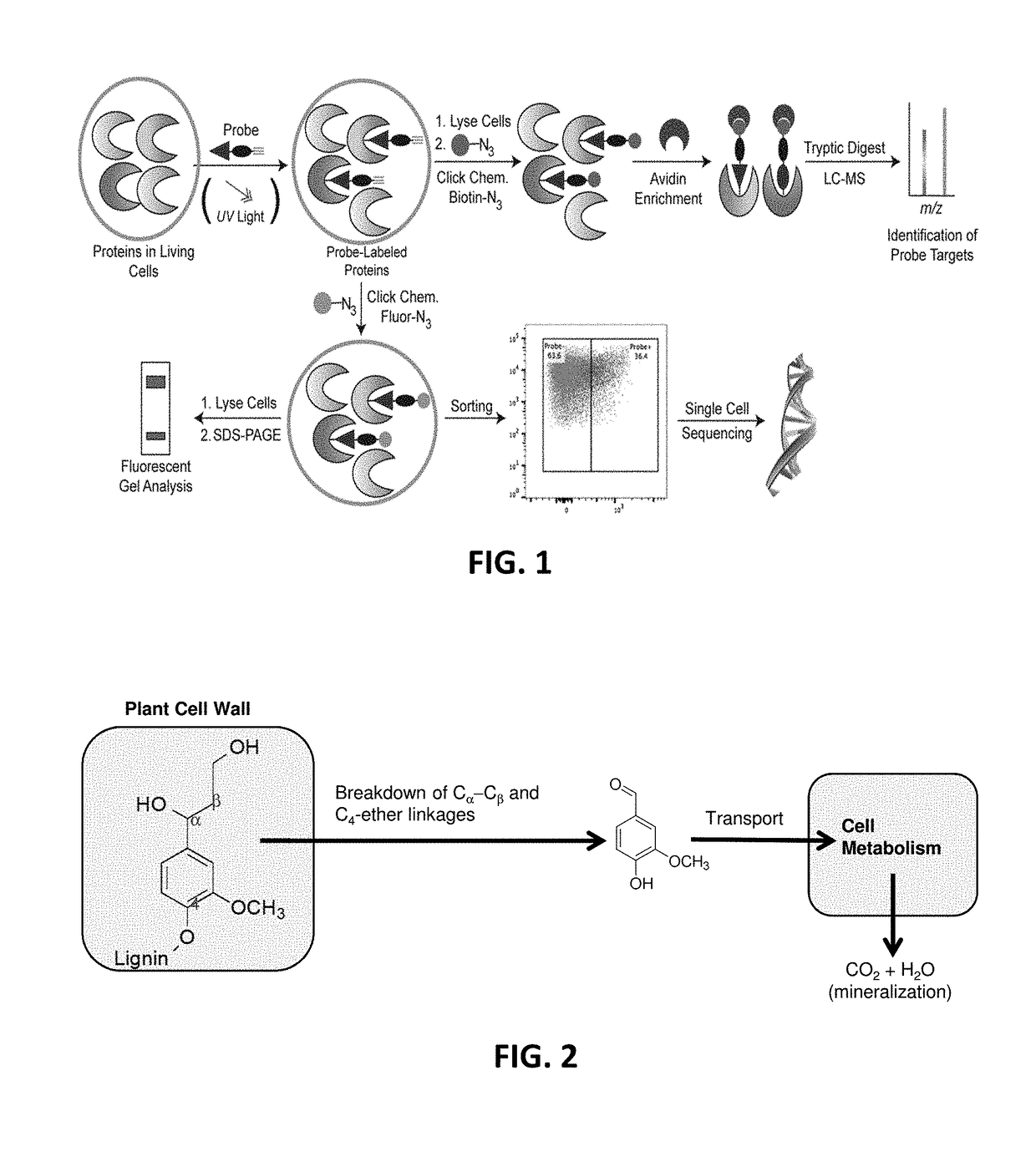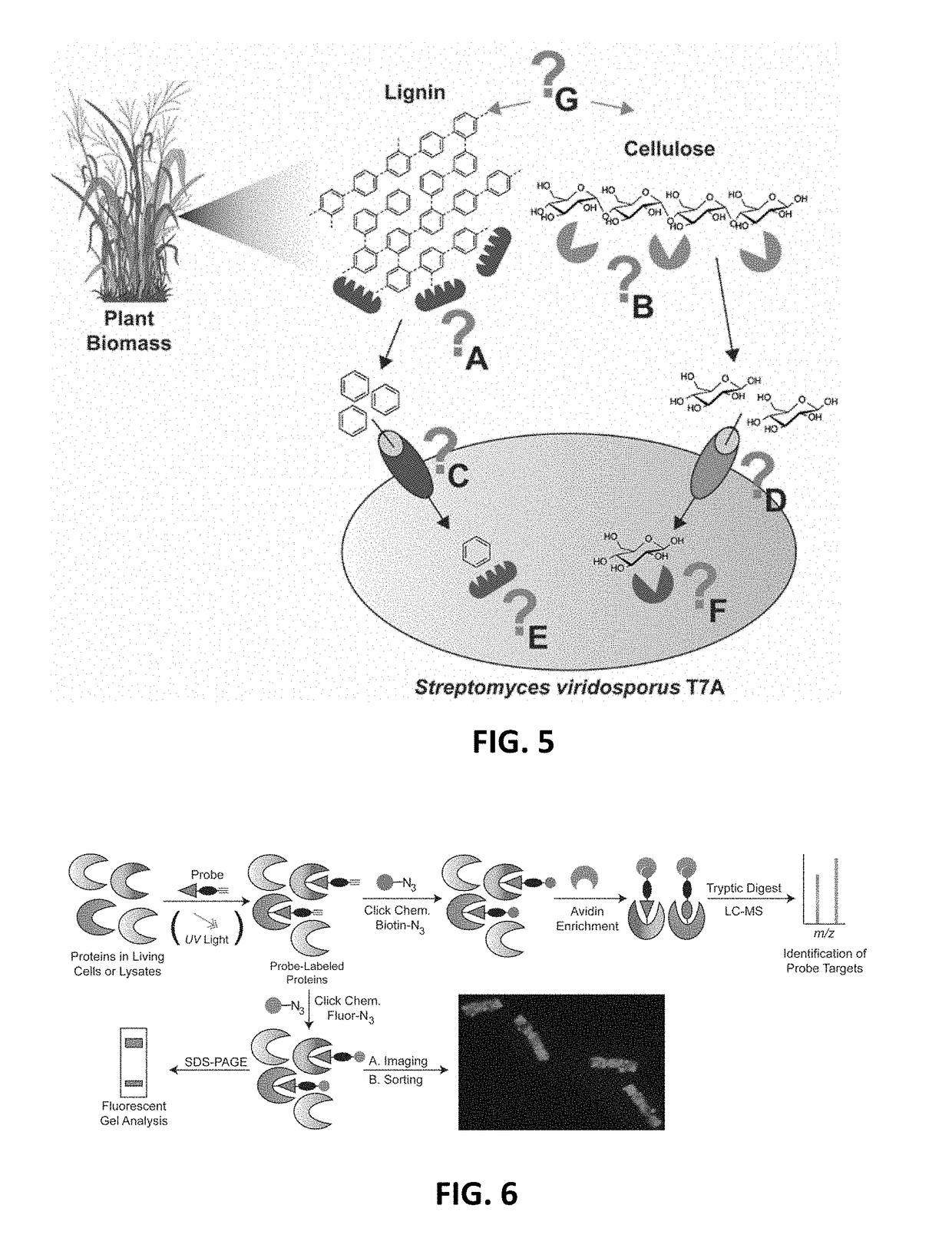Function-based probes for environmental microbiome analysis and methods of making and using the same
a technology of environmental microbiome and function-based probes, which is applied in the field of function-based probes, can solve the problems of few known to be capable of complete biomass degradation, no commercial biocatalytic process for fungal lignocellulose deconstruction, and a roadblock to biofuel production, so as to promote the formation of probe-analyte conjugates, reduce the amount of the amount, and alter the microbial metabolism in the environmen
- Summary
- Abstract
- Description
- Claims
- Application Information
AI Technical Summary
Benefits of technology
Problems solved by technology
Method used
Image
Examples
example 1
[0188]In this example, a representative device embodiment was made using the following steps. Fisherbrand microscope slides were cleaned by submerging the slides in ˜100 mL of 20% nitric acid at 85 C for 2 hours. Slides were then removed and placed in a beaker full of milliQ H2O. After soaking for 1 minute, slides were moved to a new beaker of milliQ H2O and allowed to sit for 5 mins. Slides were then transferred to a 35% H2O2 solution at 75 C for 1 hour. Slides were then removed and placed in a beaker full of milliQ H2O. After soaking for 1 minute, slides were moved to a new beaker of milliQ H2O and allowed to sit for 5 mins. Slides were moved to a beaker of methanol and allowed to sit for 5 mins. Slides were dried in 110 C oven for 1 hour (at least). A well cover was wetted with milliQ and attached to the surface of the slide. The well-attached slide was then placed back in the oven for 30 minutes to allow for drying. The device was tested for leaks by adding 1.6 mL milliQ to the ...
example 2
[0189]In this example, a representative device was used to analyze a sample. In particular, the device (such as the functionalized substrate from Example 1 above) was washed 2× with an aqueous solution containing the biological sample (for example, PBS). The sample was applied to the functionalized device surface for 3 hours with rocking (r.t. or desired temperature). The slide was washed 1× with PBS. Then, the slide washed 1× with 4% SDS with rocking at r.t. (5 mins). Then, the slide was washed 2× with DMSO (5 mins, then 30 mins with rocking). Next, the slide washed 1× with PBS, followed by washing 2× with PBS with 0.5% BSA with rocking at r.t. (first wash for 5 mins, second wash for 30 mins). Then the slide was washed 2× with 4% SDS with rocking at r.t. (first wash for 5 mins, second wash o / n). Then the slide was washed 1× with PBS, 1× with milliQ. Then the slide was washed with 6M urea with rocking at r.t. (1 hour). Then the slide was washed 2× with 1M NaCl 2× (1 min each). Then ...
example 3
[0190]In this example, glass microspheres are used to provide a multiplexing device. To solution of lysate or pure protein (50 uL, typically 1 mg / mL) in Eppendorf tubes (1.5 mL best), is added bifunctional probe (100 uM) and incubated at 37° C. for 1 h with no agitation. To this solution is added DBCO-Rhodamine545 (100 uM) and incubated at 37° C. for 1 h with 500 rpm agitation. Washing with cold (−20° C.) MeOH (500-1000 uL) and centrifugation at 16×g for 2 m at 4° C. are performed. Supernatant (will be bright pink, based on fluorophore used) is removed and repeat these three steps are repeated two times. Walls of the Eppendorf may be pink, this is normal. The sample is allowed to dry. Then, 5-10% suspension of functionalized azide microspheres in MeOH are added to protein-containing Eppendorfs. MS is pipetted into the bottom of the tubes and allow to dry completely (˜30 m, depending on volume). 100 uL 0.4% BSA in PBS is added back, microspheres are resuspended by sonication, and the...
PUM
| Property | Measurement | Unit |
|---|---|---|
| wavelengths | aaaaa | aaaaa |
| wavelengths | aaaaa | aaaaa |
| wavelengths | aaaaa | aaaaa |
Abstract
Description
Claims
Application Information
 Login to View More
Login to View More - Generate Ideas
- Intellectual Property
- Life Sciences
- Materials
- Tech Scout
- Unparalleled Data Quality
- Higher Quality Content
- 60% Fewer Hallucinations
Browse by: Latest US Patents, China's latest patents, Technical Efficacy Thesaurus, Application Domain, Technology Topic, Popular Technical Reports.
© 2025 PatSnap. All rights reserved.Legal|Privacy policy|Modern Slavery Act Transparency Statement|Sitemap|About US| Contact US: help@patsnap.com



